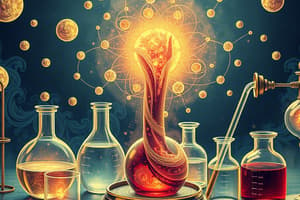Podcast
Questions and Answers
What is the purpose of using reaction indicators in chemistry experiments?
What is the purpose of using reaction indicators in chemistry experiments?
- To demonstrate solubility and lattice structures
- To visualize pH changes, oxidations, and reductions (correct)
- To mix saturated solutions
- To grow crystals
How does litmus paper indicate acidity or alkalinity?
How does litmus paper indicate acidity or alkalinity?
- By staying white in neutral solutions
- By changing color from red to blue with acids and from red to purple with bases (correct)
- By turning green with bases
- By turning yellow in acidic solutions
What happens to universal indicator when it interacts with different substances?
What happens to universal indicator when it interacts with different substances?
- It changes colors from yellow to orange, green, pink, violet, brown, and finally black (correct)
- It remains colorless in all substances
- It shows no reaction to any substance
- It turns black in acids and yellow in bases
In crystal growing experiments, what is the purpose of adding a seed crystal or waiting for small crystal clusters to form spontaneously?
In crystal growing experiments, what is the purpose of adding a seed crystal or waiting for small crystal clusters to form spontaneously?
How can one grow salt crystals using simple materials like baking soda or table salt?
How can one grow salt crystals using simple materials like baking soda or table salt?
What is the purpose of the density column experiment described in the text?
What is the purpose of the density column experiment described in the text?
In the Oobleck experiment, what behavior does the non-Newtonian fluid exhibit?
In the Oobleck experiment, what behavior does the non-Newtonian fluid exhibit?
What is the significance of observing the displacement of fluids in the density column experiment?
What is the significance of observing the displacement of fluids in the density column experiment?
Which aspect of rheology properties do experiments like Oobleck highlight?
Which aspect of rheology properties do experiments like Oobleck highlight?
What is one key benefit mentioned in the text about engaging in chemistry activities like these experiments?
What is one key benefit mentioned in the text about engaging in chemistry activities like these experiments?
Flashcards are hidden until you start studying
Study Notes
Exploring Chemistry Through Engaging Activities
For those seeking a hands-on approach to understanding chemistry concepts, there's good news: A plethora of engaging, DIY experiments await you! Let's delve into some exciting chemistry activities suitable for all ages, designed to stimulate curiosity while deepening your grasp on the fundamental principles of this fascinating science.
Reaction Indicators
One of the simplest yet most enlightening ways to explore chemical reactions is through reaction indicators. These colorful compounds can help visualize pH changes, oxidations, reductions, and more. For example:
- Litmus paper reveals acidity or alkalinity by changing color from red to blue when dipped into acids, and red to purple with bases.
- Universal indicator turns different colors depending upon the substance being tested - it goes from yellow to orange, and then green, pink, violet, brown, and finally black.
Crystal Growing
Crystals have captivated people throughout history, and they're also ideal tools for learning about solubility, lattice structures, and crystal growth patterns. You can grow your own salt crystals using simple materials like baking soda or table salt. Here's how:
- Mix saturated solution water and non-solvent.
- Add a seed crystal or wait until small crystal clusters form spontaneously.
- Hang the container upside down so that the growing process takes place only on one side of the seeds.
Density Column Experiment
This activity illustrates density differences between various substances—a concept crucial to understand in chemistry. To build your own column, follow these steps:
- Fill a plastic bottle halfway with oil (mineral oil works best), making sure to leave some air space above the liquid surface.
- Pour water into the bottle slowly until it reaches its maximum capacity without mixing with the mineral oil layer below.
- Next, carefully place objects of varying densities inside the bottle. Watch them sink or float based on their relative density compared to the two liquids and observe the displacement of fluids during the entire process.
Oobleck, Anyone?
Oobleck, often referred to as goop, is a non-Newtonian fluid created by combining corn starch and water. It demonstrates shear thinning behavior: When pressed together, oozes like a liquid; however, once released, immediately solidifies again. This experiment offers insight into complex rheology properties and nonlinear viscoelasticity.
These four examples represent merely a fraction of countless chemistry activities out there ready to ignite curiosity and facilitate learning. Aside from the joy of discoveries and insights gained, these endeavors build problem-solving skills and foster creativity. So let's dive right in and enjoy unraveling the mysteries of our world, starting with the marvelous realm of chemistry!
Studying That Suits You
Use AI to generate personalized quizzes and flashcards to suit your learning preferences.




